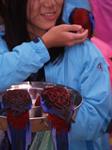
How to Attract Wildlife to A Garden
Most native gardeners welcome wildlife in their garden. Whether the animals, birds and insects are just passers-by or long-term residents, they add beauty to the garden and create a sense of movement and life.
Of course, they are not just there for our enjoyment. Our wildlife needs native plants for food, shelter, nesting and perching. Native gardens provide a welcome refuge for wildlife and help to redress the loss of habitats in their natural environments.
How to Attract Birds
Beyond the obvious entertainment we derive from birds, there is the less obvious advantage that they help control insects and other pests. To attract birds to the garden, you need to provide the following:
· A desirable habitat - places to perch and safe places to get away from predators such as cats.
· Water and food - a birdbath or shallow pond is ideal. For nectar-feeding birds, grow grevilleas, banksias and other nectar-rich native plants that flower a lot or for long periods of time.
· A wide variety of plants – a diverse garden will attract many different types of birds.
· Plants that provide nesting places, particularly shrubby plants and trees.
Bird Shelters
An established garden with a diverse range of plants, including mature trees and shrubby plants, will most likely have suitable places for birds to perch and nest. Newer gardens will benefit from nesting boxes – these can be made or purchased from pet suppliers. The box should be securely attached to a tree trunk or fence post
A good bird shelter provides:
· a place to perch
· a clear view and access on all sides, to get in and out and not be cornered by predators
· a place which has restricted access for predators. To deter climbing animals such as rats and possums getting into the box or shelter, put a wide band of metal around the tree trunk or pole, below the shelter.
How to Attract Butterflies
Australia has almost 400 species of native butterflies, most of which occur in the subtropics and tropics. They are most active during daytime in spring and summer. They flit from bush to bush, feeding on nectar-rich plants, searching for a mate, and looking for suitable plants on which to lay eggs.
While the adult butterflies feed on nectar from a wide range of flowering plants, the caterpillars (the larval stage of butterflies) only feed on the leaves of a specific range of food plants – these are sometimes called host plants. The female butterfly lays her eggs on a host plant; when the eggs hatch, the caterpillars eat the leaves on that plant. Most plants quickly recover from caterpillar attack; some even benefit from being ‘pruned’.
A butterfly-friendly garden has the following characteristics:
· A wide variety of ‘butterfly-attracting’ plants, including nectar-rich flowers and specialised caterpillar food plants
· One or more glades or open, sunny spaces, with butterfly food plants around the edges
· Plants flowering in spring, summer and autumn to provide a continuous food supply
· Informal or relatively undisturbed areas in the garden
· White or cream night-scented plants (eg. Pittosporum undulatum) to attract moths
· Avoids the use of chemical insecticides which harm butterflies and their larvae
Some butterfly-attracting plants that can be grown in most areas:
- Brachyscome multifida
- Olearia spp.
- Pimelia spp.
- Thryptomene saxicola
- Dianella sp.
- Gahnia sp.
- Lomandra sp.
- Leptospermum lanigerum
- Westringia glabra, W. longifolia
- Xerochrysum bracteatum (syn. Bracteantha bracteata)
 Attracting Reptiles and Other Small Animals
Attracting Reptiles and Other Small Animals
Diversity and informality are the key ingredients for attracting lizards, insects and small native mammals into the garden. No specific species need to be planted; it is more important to grow a wide range of trees, shrubs and ground covers for their nectar, food and sap. In addition, provide sunny rocks, leafy bark mulch and hollow logs as basking and hiding places for lizards.
COURSES TO CONSIDER
The following courses that may be of interest.
Click on any of these to go to an outline of that course.
SUGGESTED READING
Our academic staff have written a wide range of reference books, many specifically designed to fit the needs of our students. Click on any of the following titles to visit our online book store and see details on that book.

Marine Animals |

Animal Health |
|

What to Plant |
